2007
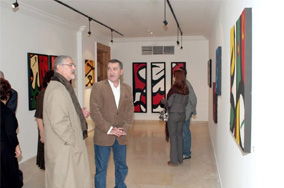
Piecing Bilbeisi's Harf II
Looking at Omar Bilbeisi's paintings is like looking through a
magnifying glass fixed over the pages of an Arabic language book.
His 29 tableaux that are on display at Zara Gallery are a delight to
the viewer's eyes as they are beautifully produced and thematically
exuberant. Bilbeisi's exhibition consists of enlarged letters from
the Arabic alphabet and Qur'anic sentences that lighten up the walls
of the gallery. Even though most of these sentences and letters are
in fragments, one can still sense their underlying message.
Bilbeisi's current exhibition, entitled Harf II, follows in the
footsteps of its prequel Harf, the subject of Bibeisi's solo
exhibition also held at Zara Gallery in 2004.
A spotlight above one of his paintings was off, yet somehow the
painting was emanating light. His brush strokes-much like a
calligrapher's only on a larger scale-are bright and far from
whimsical, as calligraphy is an art that revolves around symmetry
and measurement.
"Calligraphy in my work emancipates itself from rules pertaining to
the clarity of words and sentences in the structure that we know and
use on a daily basis," Bilbeisi says in his exhibition's press
release, adding, "the main theme of the exhibition is the extraction
of Arabic letters from their literal and logical connotations that
people use in their everyday correspondence; and using these letters
outside their context, on a backdrop of prominent colors that are
mainly borrowed from Pop Art themes."
Borrowing from "Pop Art" themes is what Bilbeisi certainly does only
on a different level. He creates strong colored spaces reminiscent
of the works of Roy Lichtenstein. However, instead of human
characters Bilbeisi uses alphabetical characters stenciled over
backgrounds of white, blue, red, yellow and green. The material he
uses in creating his paintings range between acrylic, oil and mixed
media.
Studying art in 1993 at the Ecole Nationale Superieure des
Beaux-Arts in Paris Belbeisi also took part in the studio workshop
of French Artist Ounis Amor in Paris. In 1995, he became Assistant
Director at Darat al-Funun in Amman and in 1999 he was invited to
participate in the Jordanian pavilion at the EXPO 2000 in Hanover,
Germany.
"I like to experiment with letters because they are curvaceous,
which gives my work a certain flow and a degree of fluidness, while
the colors I use, are meant to make the letters more prominent and
to bring more character and life to the letters embodied in my
work," says Bilbeisi.
Producing interwoven fragments of sentence and intertwined letters
is not an easy process as Bilbeisi has to imagine the whereabouts of
each letter, line and shape within the boundaries of a painting's
frame. While working on them Bilbeisi the artist was dealing with
incomplete images that needed to be transcribed upon canvas opposite
complete thoughts looming in his mind and this is where the
brilliance of his exhibition lies; for a sentence is a thought
comprising letters that are assembled cognitively in one's mind
before being laid on paper or on canvas.
Bilbeisi, who helped to set up Dar el-Fan Museum and Museum of
Traditional Life in Amman, held his first solo exhibition at The
Orient Gallery in Amman in 1998. Bilbeisi participated in several
group exhibitions. Besides Jordan, his works are displayed in
France, Spain, Egypt, Japan, Monaco, the UK, and the US.
One of Bilbeisi's impressive paintings comes out as an unhinged
triptych with colors of white and red adorned with black
calligraphy. This painting-as is the case with the other
paintings-can be seen as a large three-piece jigsaw puzzle that is
waiting to be solved.
What makes Bilbeisi's Harf II an interesting exhibition is that it
stirs the imagination of the viewer, who finds himself piecing the
fragments hanging on the wall and at the same time instigates the
mind into a process of thinking that might lead to an answer: The
meaning of each painting. ¦Piecing Bilbeisi's Harf I
By Mike Derderian
Star staff write
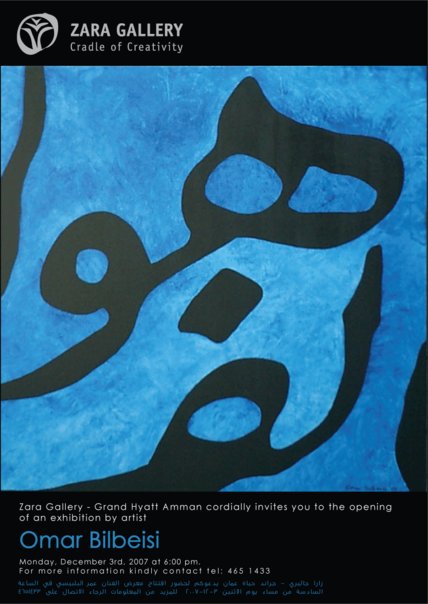
2006
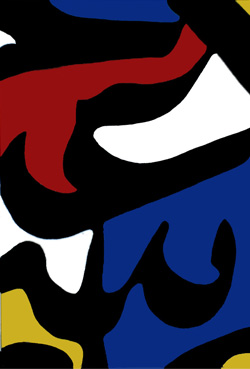
A Celebration of Jordanian Contemporary Art at 4Walls Gallery
Under the patronage of HRH princess Mona Al Hussien, A Celebration of Jordanian Contemporary Art at 4Walls Gallery showcased the works of 49 artists. Established artists with resonating names and young, new artists at the beginning of their artistic career. -- paintings, sculptures, lithographs, etchings, photos, ceramic, an installation and even “fashion” -- did give reason to celebrate. They are a feast for the eye and proof that Jordanian art can easily compete with art anywhere. Mostly abstract, but traditional as well, the works may be the product of different artists and styles but they are in amazing harmony, eliciting feelings of calm and contentment, and inviting to contemplation.
2006
“Art 4 Life” at T Canvas Gallery, Amman
At T Canvas Gallery: Art 4 Life, an exhibition dedicated to Lebanon and its people, was organized by artist Shereen Audi. The displayed works of art were donated by artists and art galleries from across the country and all proceeds of the exhibition went to Lebanon.
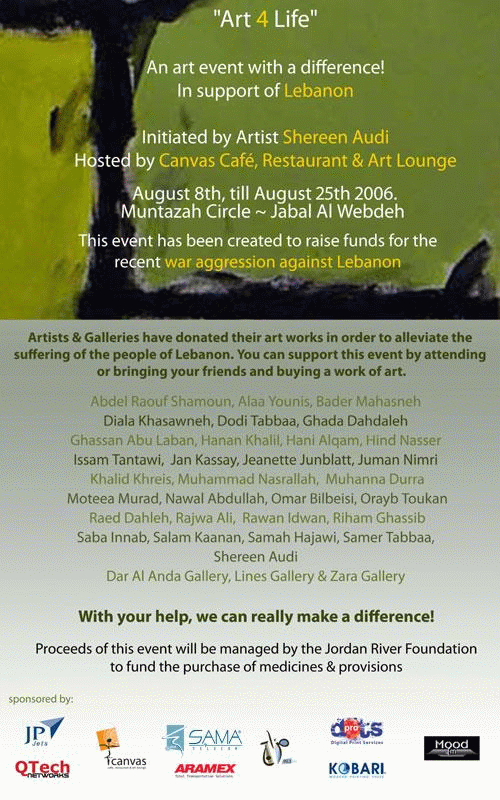
2004
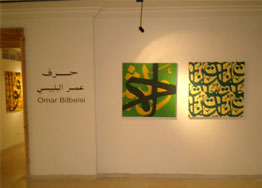
Harf I
The paintings of Omar Bilbeisi reflect his complex rapport with
the rudimentary forms that embody language – the alphabet.
Calligraphy in his works seems to emancipate itself from rules
pertaining to the clarity of words, sentences and even meaning. They
force the viewer to construct a personal significance of what is
seen through their focus on a sinuous and continuous movement of
line, color and space. The compositions and styles of representation
in his exhibition are multi fold. While some tend to reach a purist
state, others take on an expressive character, which at times pushes
the work within the margins of pop culture and kitsch. This complex
method of representation is further heightened by an infiltration of
the ‘ready made’ to his canvases (i.e. leopard skin), which -if
anything - emphasizes his resistance to an affiliation with a
particular style by belonging to all. This ambiguous position has a
double edge, which empowers the work on both critical and aesthetic
levels. On one hand it claims that originality does not necessarily
dwell in inventing a personal language of expression, nor does it
burden itself with presenting what’s never been seen. Rather, the
works concentrate on the synthesis of multiple styles into one
palette with which various visual experiences are created. On the
other hand his works points to the singularity of the subject matter
regardless of the multiple visual manifestations of that stylistic
palette.
Looking at Omar Bilbeisi’s works one tends to appreciate how
“beauty” is often concealed yet depicted through noise, ambiguity
and contradictory layers of meaning.
Sahel Al-Hiyari
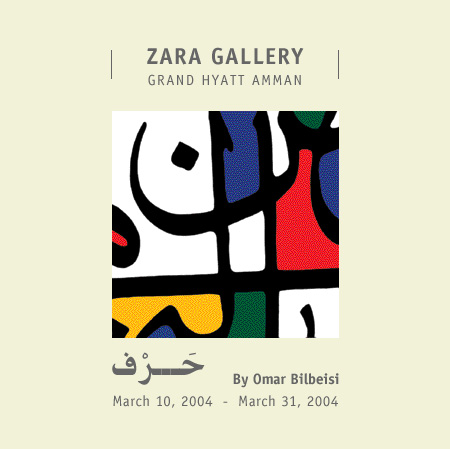
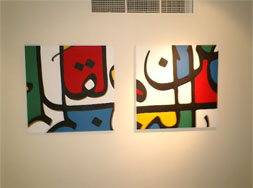
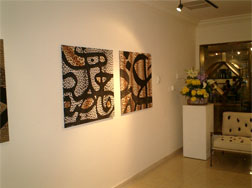

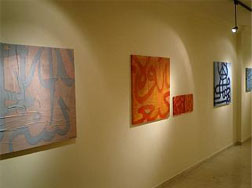
2003
Old & New at Zara Gallery Amman
An exhibition entitled Old & New was held at Zara Gallery Amman in August 2003. The exhibition featured 30 Arab artists who showcased their latest work. Omar Bilbeisi was among those that were invited to participate.

Page: 1 - 2
